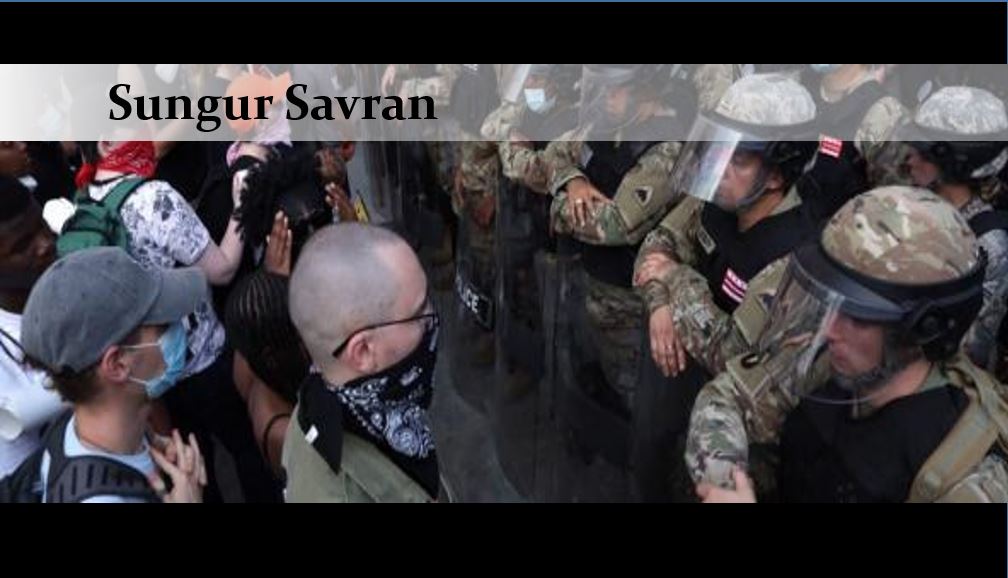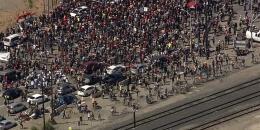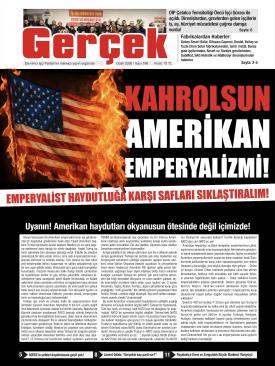The peoples’ rebellion comes to the belly of the beast: 20 theses on the George Floyd rebellion

1. So the peoples’ rebellion has come back to the United States of America. And what a comeback! At the time of writing, the people have been on the streets for three weeks already, have united black and white (and Latino/a and Asian and all the others) in the fight for justice and social provision, have defied the aggressive tactics of the police from New York to California, have humiliated Trump in his quest for recourse to the military in fighting the masses, have thus “dominated” the street, to use Trump’s military term, to the chagrin of the forces of “law and order”, and have thus wrested concessions from the forces of the established capitalist order. What achievements!
We say “comeback” for America was also present during the international upheaval of the years 2011-2013. Occupy Wall Street, commencing in late 2011 and spreading across America despite the fact that the name refers to the city of New York, arose during the first round of uprisings around the world after the financial crash of 2008 in the wake of the collapse of the Wall Street bank Lehman Brothers. It took part in the same rise in mass struggles led by the Arab revolutions of Egypt (Appeal by Revolutionary Workers Party (DIP) of Turkey: To the revolutionary people of Egypt!), Tunisia, Yemen, Bahrain, and Syria (Syria between revolution and counterrevolution) in its first six months between March-September 2011 until it degenerated into a reactionary civil war. It accompanied the popular rebellions in Spain and Greece in 2011, Turkey and Brazil in 2013, and in quite a few Balkan countries in the years 2011-2014. This was the first round of what we have characterised as the third wave of the world revolution, the first two having arisen within and in the aftermath of the two world wars of the 20th century. This international revolutionary wave erupted against the background of the Third Great Depression, into which the world economy drifted, in our opinion, after the financial collapse of 2008. Hence, the American movement was very much in sync with the nature of this series of uprisings when it called itself Occupy Wall Street. Whether it took the road to revolution as in the Arab world or the more restricted form of a popular revolt elsewhere, this movement was an insurgency against the inadequacies and the cruelties of capitalism in providing the people a decent livelihood. Already perceptible for the last three decades, the injustice and suffering caused by capitalism became all too unbearable a burden for the labouring masses under the conditions of the Third Great Depression.
That is why we insisted after the defeat in 2013 of the Egyptian revolution, the centrepiece of the entire international upheaval, that the third wave of world revolution was not over, but would come back when the trauma of the defeat of the first round was overcome and when other conditions were propitious for mass action. We underlined that, having been defeated in the streets and the squares, the masses had only retreated to the parliamentary domain in countries where this was possible, pointing to the rise of such figures and movements as Jeremy Corbyn in the UK, Bernie Sanders in the US, the Syriza of Alexis Tsipras in Greece, the Left Bloc in Portugal, Sinn Fein in Ireland, North and South, and Andrés Manuel López Obrador in Mexico. These, we stressed, presented no meaningful way forward for the problems that the masses were suffering in their respective countries, but nonetheless should be seen as symptoms of a serious malaise within the population regarding the functioning, or rather malfunctioning, of the capitalist system. In addition to this, we pointed out that exceptional mass movements such as the French strike movement in the face of the new labour law under the so-called socialist government and the mammoth protests, week after week, against the lavish corruption in which the president was engaged in South Korea, which eventually brought her down and landed her in jail, both extending over the best part of 2016, were also cut of the same cloth as the revolutions and popular rebellions of 2011-2013. All in all, we predicted that the masses would once again take the route of insurgency wherever conditions became ripe again.
And so they did. Having matured through a multitude of popular revolts in 2018, most notably in Iraq (The Iraq insurgency) and Iran (Burn all the banks, Iranian brothers and sisters, until...) as well as in France, where the Yellow Vests movement (The “Yellow Vests”: La République en marche arrière) created an immense momentum of revolt, the second round of this wave of world revolution erupted in all its splendour and might in 2019. It came back with a vengeance in the Arab world, with Sudan (A first victory for the Sudanese revolution: will the people be able to override the “orderly transition”? and Sudan: A step towards the liquidation of the revolution) and Algeria (Algeria on the brink of revolution: Système dégage!) taking the lead and Iraq (The Iraqi revolution, the key link between the Arab revolution and the Middle East revolution) and Lebanon (The peculiarities of Lebanon’s October revolution) following. It also jumped to Latin America, where the crucible of revolution is always boiling, with many countries joining the fray, most notably Haiti, Puerto Rico, Ecuador, and Colombia, and reaching its apogee in Chile. Bolivia, where a coup was staged in hardly disguised form, also became the scene of resolute and persistent mass struggles.
This new round only came to a halt with the Coronavirus. The mass movement had to retreat to closed spaces, to self-isolation and quarantine. Until America heroically burst forth! We said from day one of the Coronavirus pandemic that the masses were face to face not with a war against the virus, but with two wars and that in order to win the war against the virus, we had to win the second, no less urgent, war against capitalism. The American masses have confirmed this by taking to the streets in great crowds with masks to protect them from the twin hazards of the virus and of the tear gas amply used by so-called law enforcement.
2. The cold-blooded killing of George Floyd simply created a nation-wide crisis, to use Lenin’s concept, as a result of a single incident as he predicted. America was already boiling over and this was the straw that broke the camel’s back. The work done by the Black Lives Matter movement since 2013 was of course of fundamental importance. But the country was also ready to erupt, both because of the simmering contradictions of the period of the Third Great Depression, which became even more acute under the Trump presidency, and the recent catastrophe the country had to suffer as a result of the brutal policies of the capitalist class and the Trump administration.
3. Even before the Coronavirus crisis, the US was the scene of a growing opposition and radicalisation. America saw a rise in mass struggles and in the prestige of socialism in different spheres since the onset of the Third Great Depression and the beginning of the third wave of the world revolution. The struggles in 2011 (Wisconsin, similar movements in other states, the Occupy movement) and the rise of “Black Lives Matter” from 2013 on were the first signs of a revival that was given a clear impetus by the Sanders campaign of 2016 and Trump’s election. The success of a candidate who called for “socialism” and “political revolution” in the Democratic primaries, the size of the marches organized by women against Trump and other reactionary tendencies in American society, the teachers’ strikes in the different states, the General Motors strike, the strike by the teaching and research assistants of the University of California on various campuses, which was accompanied by a 1968 style student radicalization etc., all of these mass movements created certain remarkable political consequences as well, the most important of which were a significant growth of the Democratic Socialists of America, the electoral victory of Alexandra Ocasio-Cortez and others in her footsteps, and the initial success, up until a certain point, of the 2020 campaign of Bernie Sanders.
4. The Coronavirus laid bare the utter bankruptcy of American capitalism. The United States has become the epicentre of the pandemic, with more than 2 million cases of infection and close to 120 thousand deaths. The pandemic has revealed the limits of what capitalism has to offer humanity. The subordination of all productive activity to the profit urge of capitalists has made an effective fight against the Coronavirus impossible. Central planning, necessary for such emergency situations, was sacrificed at the altar of profitable production, thus leaving all fundamental choices to the forces of the market, which is one of the major reasons why the US, as well as the imperialist countries of Europe, failed so miserably against the virus, the other being the four-decade long deliberate destruction of health-care systems in these countries. To all of these, add the utterly irresponsible and erratic behaviour of Trump and his administration, at times bordering on sheer idiocy (most blatantly in the case of Trump’s suggestion that disinfectants be used internally to kill the virus). And after all the mayhem and the suffering, Trump undertook an irresponsibly premature reopening. Today the rate of infection is still on the rise in 21 states. 20,000 new cases are being added daily. States like Texas, California, and Florida have lately reached the highest daily toll of new cases. Unfortunately, as the US is still the trendsetter in the capitalist universe, Trump’s policy of reopening also became a model to the rest of the world, mimicked, in particular, by the Bolsonaros and the Modis and the Erdoğans in their own countries, at the cost of great risk to their populations.
5. Apart from the public health trauma, the Coronavirus crisis also led to an open class warfare on the proletariat on the part of the bourgeoisie. Under conditions of lockdown capitalism leaves the working class face to face with a stark choice between death from the virus or starvation. The lockdown has also triggered financial and economic collapse, ending 11 years of a bull run on Wall Street and creating unemployment to a level only comparable to the previous great depression of the 1930s, with job losses topping 40 million already. All of these developments have put a resurgence of class struggle on the agenda. There is serious mobilisation at the grassroots level. Workers have occasionally walked off the job in protest against unsanitary work conditions and there have been attempts at networking across enterprises within the same industry (cargo services) or across industries in certain states.
7. The eruption of rage after the cold-blooded murder of George Floyd is thus also a result of these additional factors. Millions of people on the streets today are unemployed! If we are to recap what has so far been said about the general economic and political climate, these are the major factors at play: a general turn to the left in American society, most notably with the youth turning their faces more and more towards socialism and the white working class lending an ear for the first time in decades to socialist or at least class struggle ideas; the loss of prestige on the part of both the Trump administration and the US system at large over the handling of the Coronavirus crisis; economic collapse, visibly a result of the lockdown, but in fact equally a new phase in the unfolding of the Third Great Depression (see our 2020 Stock market crash: a new phase within the Third Great Depression); and, finally, latent tendencies towards a resurgence of class struggle in the context of the brutal and callous treatment of workers face to the Coronavirus. The decisive and overriding factor is, without any shred of doubt, the pent-up outrage at police brutality against African Americans at an immediate level and against overall systemic racism at a more general level.
8. This movement has immense strengths. It has spread all over America, from New York to Seattle and from Chicago to Texas and California. This is way beyond what the Occupy movement had achieved. Media attention is directed to marches and demonstrations in central venues, such as by now the world-famous site in front of the White House in Washington DC or the central rallies in New York City, Washington Square, the Barclays Center or outside Gracie Mansion, the mayor’s residence. But there is a plethora of unnoticed marches, locally organised, in neighbourhoods such as Flatbush in New York. Not only towns where a black majority (Atlanta, Georgia) or a sizable black minority lives (countless cities all over America) but even small town white America has seen protests, in far-flung towns where the African American presence is probably counted by the dozens. The spontaneity of the movement in many areas, even sometimes in downtown areas of metropolises, is initially an advantage, as it points to the very deep feelings of solidarity in all of the participants. People come out without any organising influence. No doubt, in most areas Black Lives Matter or groupings that are networked to it have been taking the lead, which is also a positive aspect since to be following a black leadership would help erode the unconscious feelings of racism in the white crowd.
9. However, there are also weaknesses. Spontaneity and the accompanying fragmented nature of the local leaderships shuns any kind of overall strategy and thus leaves the movement without a general perspective. What was an advantage at the beginning might prove mortal at a more advanced stage. Already three-weeks old, the rebellion may very well start to dwindle. (The system seems intent on fanning the flames of outrage. Immediately after the above lines were written there was another murder in Atlanta, Georgia, when a police officer killed 27-year old African American man Rayshard Brooks, after he cooperated on each and every demand of the officer, finally attempting to save himself from the encroachment of the police when despite all he had done to cooperate, the officer tried to handcuff him.) Eventually, the movement will wither away unless an overall winning strategy is adopted. Thus self-organisation of the movement and a centralisation through delegates with specific mandates, i.e. a pyramid-shaped structure based on committees of action, is a necessity. We must not forget that the civil rights movement of the 1950s and the 1960s had a well-structured and much respected leadership and a parallel radical leadership was emerging in the movement around Malcolm X, not to mention the black power movement and the Black Panther Party. The second weakness derives from the conspicuous absence of organised labour on the scene. This leaves the rebellion as a cross-class crowd, much more open to manipulation and confusion than a situation in which labour comes forth with additional demands that are specifically working class demands but also adopts the basic demands of the African American community and of the anti-racist element within the movement.
10. The eruption of the people’s rebellion finds the US bourgeoisie extremely divided. The major reason behind this is a division that cuts across the entire international bourgeoisie, first and foremost the imperialist bourgeoisie. The onset of the Third Great Depression left all the national fractions of the bourgeoisie around the world facing the grim prospect of continuing to pursue the globalist cum neoliberal policies that had been the vogue after the post-war boom was disrupted by a depressive phase of long crisis in the mid-1970s. From 1979 (Margaret Thatcher) to 2008, for three full decades, this had been the strategy of the imperialist bourgeoisie (and its acolytes in the countries subordinated to imperialism) in order to lay the burden of the crisis on the shoulders of the working class, the small peasantry, and the poor around the world. This strategy landed the international bourgeoisie in the swamp of the Third Great Depression after the financial collapse of 2008. It is this contradiction that led a desperate wing of the bourgeoisie in all countries, first and foremost the imperialist ones, to start to look for other ways of salvation and eventually find it more and more in protectionism, nationalism, racism, bigotry, and all kinds of traditionalism (what we labelled “ideological irredentism” in an earlier article (Sungur Savran, The great challenge: winning the working class back from ideological irredentism)). This finds, for the moment, its most advanced expression in America, personified by Trump. Notwithstanding the superficial, even ludicrous opinions put forth by many bourgeois commentators (and unfortunately also some left-wing professors), Trump’s policies do not derive from his eccentricities or his personal whims, but from a very definite current of opinion within the US bourgeoisie, one we have discussed at more length in the above-cited article immediately after Trump was elected president. So the division is not Trump versus the “sane” establishment. It is the nationalist-protectionist wing of the US bourgeoisie versus its globalist wing.
11. This has led to other kinds of more concrete confrontations in the superstructure, within the state apparatus and the ideological cadres of the US bourgeois state: federal government versus state and local instances (of which there is a plethora of instances, but we will remind the reader only the differences between Trump and many governors and mayors on the handling of the current rebellion), the executive versus the judiciary, a confrontation that goes well beyond the ceaseless tug-of-war between the two branches of government under other administrations as well; the acrimonious conflict between the Trump team and a good part of the mainstream media and so on. We will presently see that the George Floyd rebellion has added a fresh dimension to these divisions.
12. We characterised Trump, politically speaking a solitary figure within the US bourgeois establishment, very early on as a proto-fascist force sui generis. Proto-fascism we distinguish from fully-fledged fascism by the absence of paramilitary forces under the command of the movement. Trump is sui generis in that not only does he not possess command over paramilitary forces, but he cannot even rely on a well-disciplined party. The Republican Party is, of course, beholden to him in terms of party politics, but not disposed to follow him to the end of his intended journey. So his forays into the implementation of his fascist or at least fascistoid ideas have remained limited as a result of these limitations. The George Floyd rebellion has brought out the fascist in Trump. From the point of view of the strategy he intended to apply in his confrontation with the people’s rebellion, his June 1 press conference and the subsequent piece of theatrics with the Bible in front of St. John’s Church should be seen as essential. This strategy was supposed to be based on (1) denial of deep-seated racism within the white population of the US and, in particular, within his own constituency; (2) defence of the police, with added stupidities such as saying “George Floyd is looking down on a great day” while discussing unemployment figures; (3) posing as the “president of law and order”, ringing quite like George Wallace and other anachronisms; (4) the militarisation of repression in order to “dominate” the streets (military warfare term); (5) a salutation sent to the “silent majority” of religious bigotry, with vice-president Michael Pence acting as his emissary within that milieu; (6) encouraging the formation of white supremacist militia. Both in his MAGA speech on May 28 and during the June 1 press conference, Trump sent a special message to the white supremacist movements, the ones he praised during the Charlottesville far right rally and the subsequent incidents in the summer of 2017. The mention of the Second Amendment to the constitution, guaranteeing the right to the bearing of guns, in a very brief speech on June 1 can simply not be taken as anything else.
13. However, intending to apply a strategy is very different from putting it into practice. Trump experienced a debacle on this issue the like of which he had not seen probably in his entire life. The military establishment, including three former chairmen of the chiefs of staff and prominent wartime generals and admirals who later served as councillor to other presidents did not mince their words in attacking Trump head on for intending to bring in the military to fight the crowds and also chided the current chairman of the chiefs of staff, Mark Milley, for consenting to be part of the Trump show by following him to the church. Milley later apologised for this himself and bluntly said it was a mistake. Even Trump’s secretary of defence Mark Esper disowned his idea of employing the military in quashing the rebellion. Republican bigwigs as reactionary as George W. Bush, Mitt Romney or Colin Powell (the latter going so far as to call Trump “a liar”, whereas he himself is notorious for having lied before the war on Iraq to the whole world by claiming at a high-tech presentation at the Security Council of the United Nations that that country wielded weapons of mass destruction, which the US government later admitted was utterly false) disowned Trump, the latter even going so far as to say that he would vote for Biden in November! Trump had to withdraw the National Guard form Washington DC. Let no one imagine that this is the “American democratic system” that reacted to the folly of Trump. Admiral Mike Mullen, top military councillor startlingly to both Bush Jr. and Obama, made it clear that having won back the confidence of the American people it had lost because of the Vietnam War after half a century, the US military could not afford to lose it in street battles with its own citizens. The military establishment wishes to keep its hard-won prestige so as to be able to act as saviour of last resort should a real revolutionary crisis erupt now or in the future. A similar defeat seems to be occurring in the domain of the formation of a MAGA militia. Trump has suffered such a crushing defeat on the issue of his strategy of dealing with the rebellion that his presumptive rival for the presidential election Biden has mocked him by saying that if Trump refuses to turn the presidency over despite defeat, the military “will escort him from the White House”! Need we add that Trump’s debacle is but the result of the hardships suffered by a fascistically inclined politician without a paramilitary force of his own and even a disciplined party behind him?
14. The deep and acrimonious division within the US bourgeoisie pushes the Democrats and their supporters in the media to support the George Floyd rebellion to a level much deeper and much more complete than the usual role that party has played in absorbing and winning back into the limits of the established order any mass movement. This of course goes hand in hand with an attempt to soften the more radical demands of the movement. Biden visits the Floyd family before the funeral and preaches empathy, but is, quite naturally, against defunding the police. The Democrats are simply trying to gain advantage for the November elections, all the while keeping the overall system intact with merely cosmetic changes. There is nothing, we repeat nothing that the mass movement can expect from the Democratic Party establishment.
15. Neither can the movement obviously expect anything from the self-declared “socialist” wing of the party. Here is a mass movement, unexceptionable in its goals, of a size that the US has not seen for decades and Sanders the socialist makes do with an unremarkable condemnation of the killing of George Floyd and of “systemic racism and police brutality” in a video of… May 29. Apparently the man had to think in order to choose his words for four full days! He does condemn police brutality, but is against defunding police.
This is totally in line with his latest moves concerning the Democratic nomination process. He threw the towel by not only dropping out of the race, but also openly and unconditionally endorsing Biden’s candidacy as early as April. Having called for a “political revolution” for long, Sanders has now achieved to open up a “political counter-revolution” by his endorsement, since he is now giving his support to the candidate of the Wall Street establishment, of the 1 per cent. It should also be noted that Sanders acted much more in a hurry to support the Wall Street candidate than he did in 2016, when he declared his support for Hillary Clinton only in mid-July. Why did he change his tactical line this time? This question is vital. On the one hand, Sanders says he will not pull out of the primaries in order to win as many delegates as possible so that “our program” can be defended as strongly as possible. This should be read as saying “we will negotiate with the Democratic apparatus and Biden for positions and concessions”. But, on the other hand, only several days after he said they would try to obtain as many delegates as possible, he hurries to declare his full and unconditional support to Biden, thus making the number of delegates he has at the Democratic Convention irrelevant. Why this contradiction? Because as opposed to the 2016 campaign, taking place in a context in which social life was a sea of calm (excepting the Afro-American scene) and it was he who was pulling the masses forward, this time there is a social tempest due to the brutality and callousness with which the capitalist class and its representatives in power treat the working class face to the Coronavirus and the economic crisis that is accompanying it. Sanders hurried to make common front with Biden so as to keep his followers from mixing with the possible insurgencies of the working class and the oppressed masses until the elections. His quasi-indifference to the George Floyd rebellion only goes to confirm this analysis.
As for Alexandra Ocasio-Cortez, she supported the demand to “defund the police” on… June 7. As far as we know no one has seen this young woman, not running serious health risks in the Coronavirus crisis, in any of the marches. Only Ilhan Omar, among the much-acclaimed names, supports the decision in favour of the abolition of the police department in favour of “community based safety” in Minneapolis. This is scandalous behaviour for Sanders and AOC! The only Sanders who talked out on the very first say said: “could have easily been me”. His forename is not Bernie but Emmanuel. He is the renowned NFL star, African American receiver of the New Orleans Saints!
16. The priority task that socialists need to strive for is to persuade the movement to organise itself. There should be no let up, this is the moment to continue the fight and achieve results. The weakest links will gradually drop out of the movement if no nation-wide network of representative committees is formed. It is of course neither possible nor desirable to formulate an exhaustive list of demands from afar, without the ability to hold the pulse of the mass movement despite our communication with US comrades. We will nonetheless mention several so as to be able to bring out a certain methodology: (1) Open police disciplinary records! This has already been achieved (only as a matter of principle) in New York state. It is very important to be able for the mass movement and its representatives to open the dirty records of the racist killer cops. However, beware, since, like the account books of the corporations, the police departments may only show cooked versions of these records. (2) Disband police unions that defend racist policing! Trade unions are to be defended even in the case of the forces of repression for they function to remind the rank and file police officer that after all he or she is in the same position as the ordinary worker of demanding this or that set of rights. However, so many of these unions have persistently resisted any kind of solutions for racist policing that they have proved hopeless regarding a change from within. (3) Defunding is simply a high-sounding term for cuts in the budget of police departments. This is good as long as the funds thus released effectively flow into real social services that will benefit the people. But it will do nothing to eradicate racism in the police force. Abolish police departments! Community- and workplace-based militia of all the workers and citizens where each is a police officer at different times of the day and of the week is the true solution. This is a demand that has fermented from within the masses as a solution to a dire problem, but, significantly enough, coincides with the historic demand regarding policing within certain sectors of the socialist movement. (4) Bring down all statues that honour pro-slavery historical figures and Confederate flags! Rebut all demagogic discourse about the past not being something one can simply leave behind. Statues that honour racists, pro-slavery politicians and Confederate generals, and slave traders are an insult to the offspring of slaves in the present time. Not only that, they are an offence to the intelligence of our new generations, revering as they do shameful acts. Defending these in the name of preserving historical memory and heritage is like defending a Hitler statue in Berlin or a Mussolini statue in Rome. There can be only one statue of Mussolini that should be preserved, one that shows him hanged from his ankle!
17. There will be no definitive solution to the racist pest unless the working class steps in. For racism and colonialism are the most effective weapons that the capitalist class uses in order to divide the workers. Only if the white workers or at least their political vanguard are won over to the struggle will the balance of forces change radically and fundamentally. This is also the most propitious moment for stopping the capitalist class’ murderous onslaught on the working class. The movement should fight to push unions for mobilisations. In order to win over as much of the organised working class and its organisations over to the cause, a broad fighting coalition of class struggle unions and locals should be formed. But although the working class must do everything necessary to move the unions forward, it cannot, nonetheless, abandon the final say to the union bureaucracy. There are situations where not even maximum rank and file pressure may be able to move the bureaucracy. The task then is also to organise grassroots networks within and across industries and factory and workplace committees. Black and white, unite and fight!
18. The George Floyd rebellion is also important because movements of contestation against the established oppressive and exploitative order in America usually have an immediate impact on the other advanced capitalist countries. This was true of the struggle against the war in Vietnam. This was true of the anti-war movement in the case of Iraq in 2003. This was true in the case of the UK with the Occupy movement. This has happened with this movement as well. The American revolt has triggered similar movements in other climes, from the UK through continental Europe all the way to Australia and New Zealand. In these countries the demonstrations have brought back local ghosts and led to the destruction or the sullying of statues belonging to slave traders or racist bigots such as Gladstone, renowned 19th century British prime minister, or Winston Churchill in Bristol and London. The case of Adama Traoré, murdered by the police in 2016, has now been reopened in France etc. So having been inspired by the popular revolts in distant countries, the American people are now themselves exporting a rebellious disposition to other countries.
19. America is not the only country that is extremely tense in the wake of the Covid-19 crisis. The whole world is bracing nervously for new trouble, wherever that may be. The virus has come in the midst of a great depression and a revolutionary wave and laid bare the voraciousness of capital and the brutal nature of the capitalist exploitation process. The failings of a system based on the anarchy of the market and the subordination of the entire production processes of capitalism to the extraction of surplus value (of profit) in coping with the virus, its inability to crush the menace early on, now leaves all capitalist countries (save some Asian ones) face to face with the dilemma of choosing between a resurgence of the epidemic and total economic collapse. The petty-bourgeoisie, having suffered the consequences of the first round of the lockdown, is looking to the future with great anxiety. Either the political independence of the working class will be achieved and it will politically lead the rest of the oppressed and exploited against this murderous system or the fascists (from the proto-fascists of Europe and America to the clear case of the BJP/RSS regime in India) will win the day.
20. The only way out is to organise. Organise revolutionary vanguard parties and a revolutionary International around the world. In those countries where even the vanguard of the working class will more than probably resist the idea of a Leninist revolutionary party at this stage of the struggle, the way forward is the transitional organisational measure of building a mass Labor Party. This is what is needed in America. This is what the comrades of the United Front Committee for a Labor Party is fighting for.














